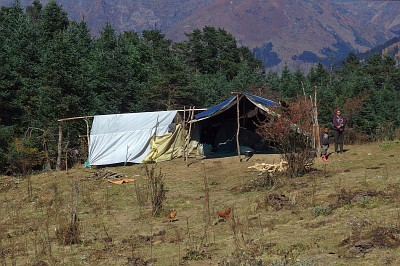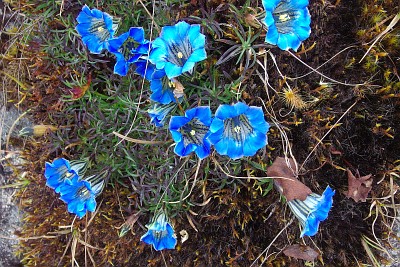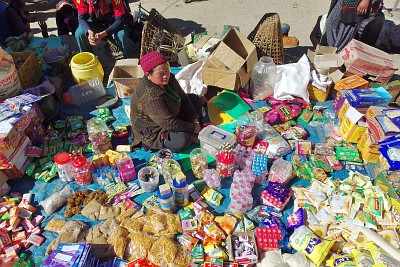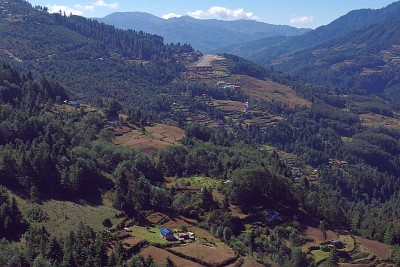Solukhumbu Foothills
(vero;2016-August-15)
Back from Daman and after a few days in Kathmandu we decide to set off again for the mountains. And because we are well into the tourist high season and want to avoid the crowds, we choose to return to the lower Solukhumbu and trek a while on the Jiri - Lukla trek. This is a trek we know very well as we have done it so often but we are always happy to meet old acquaintances and places, it feels a bit like home.
If you are looking for more information on the Everest trek, we have a detailed day-by-day description with pictures of the trek we did in March 2010 from Jiri to Namche Bazaar and the valleys above Namche (Lobuche, Gokyo, Chukhung, Kunde to Ama Dablam Base Camp).
From Jiri to Phaplu (14 days, 24 Oct 2016 to 06 Nov 2016)
- 24-25 Oct: Kathmandu to Labchane via Jiri and Those
- 26-28 Oct: Labchane to Junbesi via Bhandar and Sete
- 29 Oct-03 Nov: Rest days in Junbesi and at the Everest View Lodge in Phurtyang
- 04-06 Nov: Back to Junbesi and on to Phaplu
24-25 Oct: Kathmandu to Labchane via Jiri and Those
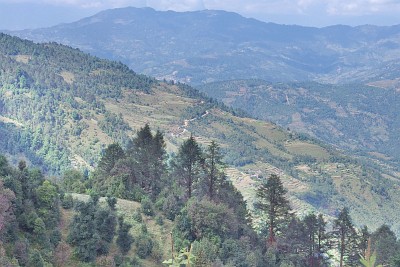 We leave Kathmandu early in the morning and our bus makes good progress although the road deteriorates quite badly once we leave the Arniko Highway and take the Jiri road. Suddenly we see many traces of the 2015 earthquake along the way: landslides, rocks piling along the road, many villages with newly built corrugated iron huts shining in the sun. The arrival in Jiri is quite a shock. The town has suffered badly and many houses, among them lodges where we have stayed in previous years, have simply disappeared. We arrive in Jiri at 13:30 and after stocking up on biscuits and noodle soups we are glad to leave the town and start the trek. The going is easy as we simply follow the dirt road to Those, our first overnight stop.
We leave Kathmandu early in the morning and our bus makes good progress although the road deteriorates quite badly once we leave the Arniko Highway and take the Jiri road. Suddenly we see many traces of the 2015 earthquake along the way: landslides, rocks piling along the road, many villages with newly built corrugated iron huts shining in the sun. The arrival in Jiri is quite a shock. The town has suffered badly and many houses, among them lodges where we have stayed in previous years, have simply disappeared. We arrive in Jiri at 13:30 and after stocking up on biscuits and noodle soups we are glad to leave the town and start the trek. The going is easy as we simply follow the dirt road to Those, our first overnight stop.
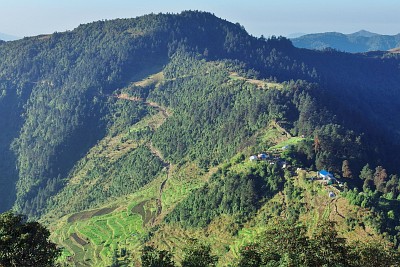 Those is a bigger shocker as Jiri. Many houses are in ruins and it reminds us of scenes of a war zone as seen on TV: half walls still standing, open roofs. We had expected similar scenes in the Manaslu area or Kathmandu but not here. It is probably due to the fact that houses in the Manaslu area are simple farmsteads easier to rebuild, the walls made of wood or stones often without mortar. But people are richer in the Solukhumbu and the houses are bigger, made from stones and mortar and the most of them with at least one storey, they are not so easy to rebuild and they cost much more.
Those is a bigger shocker as Jiri. Many houses are in ruins and it reminds us of scenes of a war zone as seen on TV: half walls still standing, open roofs. We had expected similar scenes in the Manaslu area or Kathmandu but not here. It is probably due to the fact that houses in the Manaslu area are simple farmsteads easier to rebuild, the walls made of wood or stones often without mortar. But people are richer in the Solukhumbu and the houses are bigger, made from stones and mortar and the most of them with at least one storey, they are not so easy to rebuild and they cost much more.
There is only one lodge open in Those and the landlady is extremely unfriendly so we end up staying with a nice local family who has an empty room and is happy to earn a bit of extra money.
We leave Those early the next morning and are lucky to meet two Nepalis outside the village who point us in the right direction to Labchane. This is new territory for us and we are not sure of the way. We eventually come to a road which we follow in want of an obvious path to avoid or shortcut it. We stay on it for quite a long time until we stop for a break at a house near a bend where people are waiting for a lorry. We are happy to hear that this is exactly the point where we have to leave the road and take a path which will lead us to a pass on the ridge and then to Labchane.
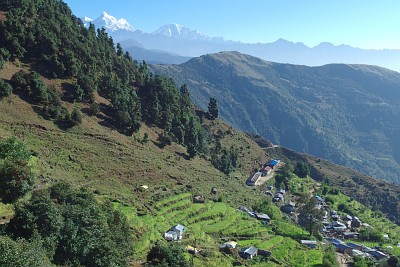 We reach some farms and we know from experience that we have to be careful: it is easy to pick the wrong path from the many confusing trails leading to fields or water spots. Unfortunately there is nobody around to ask for directions except two young girls who seem scared of us and flee when we address them. We continue and inevitably manage to lose the path. After 45 minutes of fruitless wandering along the hill we decide to go back to the farms and finally spot a man working in his field above the houses. It turns out that we had seen the path forking to Labchane but had dismissed it, not even tried it, as it looked so overgrown and ill-maintained… Fortunately, the path gets much better after a few hundred meters and it is a pleasant walk up the hill. When we emerge at last on the crest we can see Labchane 100 meters lower on the other side.
We reach some farms and we know from experience that we have to be careful: it is easy to pick the wrong path from the many confusing trails leading to fields or water spots. Unfortunately there is nobody around to ask for directions except two young girls who seem scared of us and flee when we address them. We continue and inevitably manage to lose the path. After 45 minutes of fruitless wandering along the hill we decide to go back to the farms and finally spot a man working in his field above the houses. It turns out that we had seen the path forking to Labchane but had dismissed it, not even tried it, as it looked so overgrown and ill-maintained… Fortunately, the path gets much better after a few hundred meters and it is a pleasant walk up the hill. When we emerge at last on the crest we can see Labchane 100 meters lower on the other side.
We spot a house just below the ridge overlooking the village and we hope it is a lodge; the setting is splendid with views down the valley and to snow summits in the distance. We learn that there used to be a lodge here but the earthquake has destroyed it and the family running it has retreated to their old farm building, the house which we are now seeing. It has also been damaged but they have repaired it with material taken from the lodge and are now living of farming. We ask a woman whether we can stay for the night but communication is difficult. She does not speak English and gives us to understand that she has to check with her husband first. She phones him and tells us he is on his way. We wait for quite a long time, but we are keen on staying and are hopeful that he will come at some point in time. The lady seems also keen on having us and is nervous that we might lose patience; she keeps asking us to wait. When he arrives at last, there is no problem and we agree very quickly on a price for food and lodging. The room is quite basic but we are happy to settle here for the night and are very well cared for with a huge dhal bhat and hot tea. In fact, when we go down to explore Labchane, we realise that we probably could not have stayed in the village; it is again a scene of desolation with many houses ruined, some rebuilt either with wood or iron corrugated walls and roofs. The villagers are busy repaving the road linking the school and the village and the atmosphere is a sad and depressing one. We are much better up on the ridge with our farmer family.
26-28 Oct: Labchane to Junbesi via Bhandar and Sete
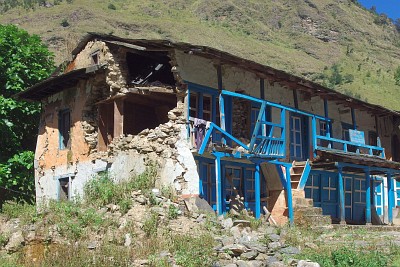 The sky is clear when we wake up the next morning. We get up quickly, rush along the ridge and climb on a nearby summit (3070m) to enjoy the views. We have two panoramas taken from the ridge above the village.
The sky is clear when we wake up the next morning. We get up quickly, rush along the ridge and climb on a nearby summit (3070m) to enjoy the views. We have two panoramas taken from the ridge above the village.
We leave our friendly hosts and make our way to Deorali, a lodge settlement on a pass where we will regain the “normal” trek. This is a nice walk but we have to be careful as we do not know the way and navigate “by instinct”; the path disappears sometimes and we have to search for new ones going in the direction we want to go. We eventually regain the ridge and come to a pass. We should continue straight forward across the pass to follow the ridge but there is no path to be seen. There is only a trail either going north to Shivalaya or south where we definitely do not want to go… We are a bit at a loss when suddenly a man appears coming from Shivalaya. We ask him for the way to Deorali and he tells us to take the way to Shivalaya which we find strange as it is clearly the wrong direction but we follow his advice; we have not gone 20 meters that he calls us back and points to our right. Indeed, hidden by scrubs and trees, we see the Deorali way branching off shortly after the pass. We would have never found it without his help, we were really lucky to meet him right at this place and at this moment! 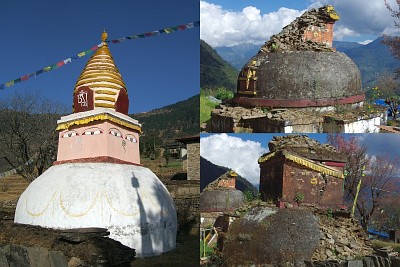
We have very nice views walking along the ridge and another bad surprise awaits us at Deorali, many lodges have been destroyed, only two of maybe six are open. We are surprised and glad to see that the long mani-walls have survived. We make an extended break and continue to Bhandar where we cannot believe what we see as we arrive. We know Bhandar very well, have been there so many times, we have our favourite lodge there, we always buy biscuits at the same shop. Well… it is so bad that we struggle to find the spot where our lodge was. We find the landlady now living in a wooden shed. Further down we discover that the stupas have been heavily damaged. The monastery is being rebuilt and we eventually find the only open lodge in the village. We know it from the past and its owners have just re-opened it. The upper storey had collapsed and had to be rebuilt with wood, the rooms separated by thin ply-wood walls. It feels like a time warp and reminds us of the “old” lodges when we first visited in 1994, before everything became more touristy and the lodges grew bigger and bigger…
It is hard to describe how we feel. We are sad and struggle to recognise the place. We decide to walk to “Bhandar Market”, the part of the village which has sprung out at the end of the dirt road, some 30 minutes away. That is where most of “Old Bhandar” inhabitants seem to have retreated and we see that many new shops have opened. There are new houses made out of wood and even more iron corrugated huts. And we discover that there are now quite substantial lodges around the bus station. For us, it is clear that Old Bhandar is dead. Some lodges will surely be rebuilt for the trekkers, the farmers who are still there will stay (some have started planting tea) but most inhabitants will stay at Bhandar Market if they do not leave the region for Kathmandu or some Terai town.
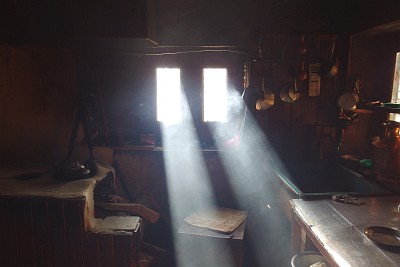 From Bhandar, we go the following day to Kenja where we arrive for lunch. The path between the two villages is one of the best walking experience on the Jiri trek with great views on the valley below. Kenja greets us with the same image of devastation, but it is not so heartbreaking as in Bhandar because the village has always been more a lodge settlement as a “real” village. Nevertheless, only four lodges (from maybe fifteen) are open for business. We soon start the climb to Sete where we want to stop for the night. We know this climb very well and here again, we know each small house, each farmstead along the way and we are sad to see so many of them closed and abandoned. Many have been damaged from the quake and are now unsafe to live in. The people have left and we wonder where they might be. Maybe Bhandar Market?
From Bhandar, we go the following day to Kenja where we arrive for lunch. The path between the two villages is one of the best walking experience on the Jiri trek with great views on the valley below. Kenja greets us with the same image of devastation, but it is not so heartbreaking as in Bhandar because the village has always been more a lodge settlement as a “real” village. Nevertheless, only four lodges (from maybe fifteen) are open for business. We soon start the climb to Sete where we want to stop for the night. We know this climb very well and here again, we know each small house, each farmstead along the way and we are sad to see so many of them closed and abandoned. Many have been damaged from the quake and are now unsafe to live in. The people have left and we wonder where they might be. Maybe Bhandar Market?
We arrive early in Sete. A new fancy lodge has opened at the entrance of the settlement, but we push on to find out that the lodge where we often stayed has also closed. We end up in the “Sherpa Guide Lodge” where we had already stopped once. There is no electricity and we are the only guests, all others are in the first lodge. Our host Dawa (54 years old) is very nice and welcoming and we spend a pleasant evening with him in his kitchen. He has three sons who are all studying and he is worried about the future of his lodge and tourism on this trek. His wife is a “health worker helping pregnant women” as he tells us, probably a midwife, and she is currently in Pokhara for training.
We leave Sete early the next morning and continue the ascent to the Lamjura-La (3530m), one of the two high passes on the way to Jiri. After the climb to the pass, the walk to Junbesi is pleasant. We stop in one of the first lodges at the top of the village. The House Namaste looks very inviting with its nice and colourful garden.
29 Oct-03 Nov: Rest days in Junbesi and at the Everest View Lodge in Phurtyang
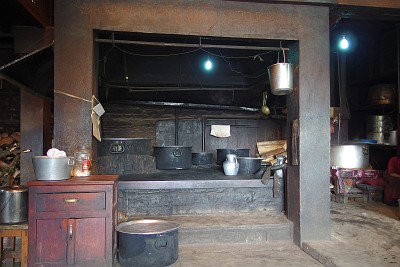 We spend two rest days in Junbesi. Thomas has caught a bad cold and we prefer to take it easy. The village has also been hit by the earthquake but many houses are still standing and the extent of destruction seems much lesser than what we have seen on the way. Many houses are nevertheless abandoned and the school and the stupa at the village entrance are in the process of being rebuilt. Many lodges are closed; the earthquake has probably taken its toll but to top it all, the Jiri trek is not so popular as it used to be and the stream of trekkers has been on a downward slope for a long time. We spend a day visiting Thupten Choling Monastery. We sit in the inner courtyard and watch how nuns come and go carrying huge sacks full with potatoes which they empty on the floor. There are 500 to 600 monks and nuns in residence and they must all be fed, no wonder they need such quantities. We make our way to the monastery kitchens which are huge and reminiscent of Henry VIII's kitchens at Hampton Court in England; they look very impressive with their enormous hearth. We are made welcome and invited to some milk tea and we spend a long time there watching the bustle around us, sharing our table with monks and workers who come here to have a meal or a tea before moving on to their duties.
We spend two rest days in Junbesi. Thomas has caught a bad cold and we prefer to take it easy. The village has also been hit by the earthquake but many houses are still standing and the extent of destruction seems much lesser than what we have seen on the way. Many houses are nevertheless abandoned and the school and the stupa at the village entrance are in the process of being rebuilt. Many lodges are closed; the earthquake has probably taken its toll but to top it all, the Jiri trek is not so popular as it used to be and the stream of trekkers has been on a downward slope for a long time. We spend a day visiting Thupten Choling Monastery. We sit in the inner courtyard and watch how nuns come and go carrying huge sacks full with potatoes which they empty on the floor. There are 500 to 600 monks and nuns in residence and they must all be fed, no wonder they need such quantities. We make our way to the monastery kitchens which are huge and reminiscent of Henry VIII's kitchens at Hampton Court in England; they look very impressive with their enormous hearth. We are made welcome and invited to some milk tea and we spend a long time there watching the bustle around us, sharing our table with monks and workers who come here to have a meal or a tea before moving on to their duties.
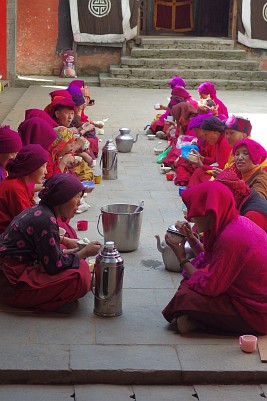 Our second day is lazy and we idle in the area around the village, go to Serlo Monastery where around 70 boys aged 7 to 20, most of them coming from very poor families, are taught and cared for by monks. It is a Saturday and since monks do not work on Saturdays, we see some of them visiting our lodge in the evening. They come here for dinner and our landlady is quite busy cooking chow mein for them. She tells us that they regularly come every week, sometimes up to twenty five of them (tonight they are only six), happy to eat something else than the sempiternal succession of dhal bhat and thukpa they get at the monastery.
Our second day is lazy and we idle in the area around the village, go to Serlo Monastery where around 70 boys aged 7 to 20, most of them coming from very poor families, are taught and cared for by monks. It is a Saturday and since monks do not work on Saturdays, we see some of them visiting our lodge in the evening. They come here for dinner and our landlady is quite busy cooking chow mein for them. She tells us that they regularly come every week, sometimes up to twenty five of them (tonight they are only six), happy to eat something else than the sempiternal succession of dhal bhat and thukpa they get at the monastery.
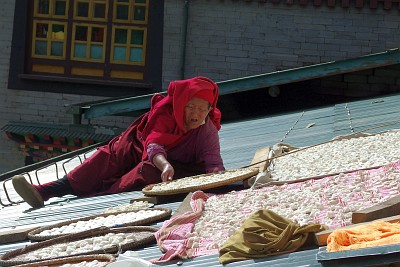 We are a bit tired of trekking and do not fancy the idea of going higher up and facing the cold evenings and nights which await us. It does not take long to convince ourselves that we would be much better off in the plains. We decide to shorten the trek and instead spend some time in the Terai town of Janakpur before continuing to Pokhara and Kathmandu. However there is one thing we want to do before we leave: overnight at the Everest View Lodge in Phurtyang.
We are a bit tired of trekking and do not fancy the idea of going higher up and facing the cold evenings and nights which await us. It does not take long to convince ourselves that we would be much better off in the plains. We decide to shorten the trek and instead spend some time in the Terai town of Janakpur before continuing to Pokhara and Kathmandu. However there is one thing we want to do before we leave: overnight at the Everest View Lodge in Phurtyang.
Phurtyang is one hour and a half walk from Junbesi on the trail to Lukla and is the first place where one can see Everest. However, it is too near to Junbesi for most trekkers to stay overnight and although there are two lodges, hardly anybody stays there for the night. The Everest View Lodge is the most inviting lodge with a nice terrace, direct views to Everest and friendly owners who sell excellent yak cheese and serve tea to trekkers stunned by the view.
In the end we stay three nights in Phurtyang. The setting of the lodge is so pleasant (our room with a view facing south is pleasantly warm), our hosts are so friendly that we don't feel like leaving soon.
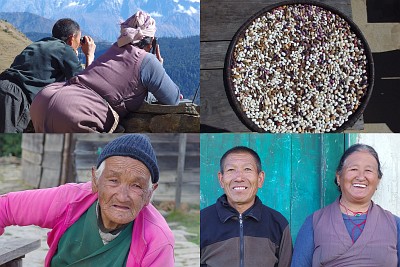 Kando Sherpa is 60 and her husband Nawang Sherpa is 68. They have eight children, four sons and four daughters. A son lives down the valley in the old family house in the hamlet of Phera on the dirt road linking Phaplu to Ringmo and one of Kando's and Nawang's favourite past time is to watch their grand children with binoculars. This son and the second one are currently on trek with tourists. The third son is a Lama and teaches in a monastery in Kathmandu and the fourth son still studies in the capital.
Kando Sherpa is 60 and her husband Nawang Sherpa is 68. They have eight children, four sons and four daughters. A son lives down the valley in the old family house in the hamlet of Phera on the dirt road linking Phaplu to Ringmo and one of Kando's and Nawang's favourite past time is to watch their grand children with binoculars. This son and the second one are currently on trek with tourists. The third son is a Lama and teaches in a monastery in Kathmandu and the fourth son still studies in the capital.
Three of the four daughters are married, two of them living in the USA and the third one married to a Western helicopter pilot lives now in Bhutan. The fourth one is in Kathmandu. Kando's mother is also living at the lodge. She is 85 years old and cannot speak. We hardly see her, she wakes up early, has her breakfast and disappears in the garden below the terrace where she spends the day in the sun or under a lofty shed sorting grains and beans or tying weeds. She comes up on the terrace for lunch then goes back to the garden and only retreats to her room when the sun starts setting down. Kando brings her dinner in her room.
We spend hours on the terrace lazying in the sun. In the morning, we watch the coming and going of trekkers. This is the busiest time of the day for our hosts. They sell tea, biscuits and of course yak cheese. They also serve the occasional meal. Kando is a fiercer business woman as her husband and quotes quite high prices, Nawang is much “fairer”. The tourists do not seem to mind anyway and often pay without any bargaining.
It gets much quieter after 11:30. Nawang is always busy, cleaning, cooking, farming and doing some maintenance jobs. One morning he goes to Junbesi in his best clothes for shopping. He is the one effectively running the place and not much would happen without him. Kando has a quite relaxed life in comparison, probably well-earned after having raised eight children. On the second day, we spend the afternoon following the path to Ringmo, but stop at the bridge before the final ascent to the village. We go through Sallung, the settlement before Ringmo. There is a better view of Everest to be had from there but the place gets hidden from the sun much quicker than Phurtyang, so it is colder. We see only one lodge and it is closed.
On the third day we decide to go up the ridge over the lodge. We have to climb around 400 meters and arrive on a high plateau with great views of Numbur, Katang, Karyolung and the mountain chain from Everest to Mera. It is definitely worth the effort and a good reason for spending at least a day in Phurtyang. We stay a long time soaking up the scenery and observing the air traffic flying into Lukla. The helicopters and planes seem very near as they fly above our heads. A family lives on the plateau under a makeshift tent. They tend their cattle and have chickens and a dog. We see the children coming back from Junbesi with their mule loaded with goods as we set to go back to Phurtyang.
We have three panoramas showing the mountain views from Phurtyang at sunset or dawn in our photo section.
04-06 Nov: Back to Junbesi and on to Phaplu
We wait until 14:15 to leave Phurtyang and go back to Junbesi on our last day. We leave for Phaplu the following morning after a lazy breakfast on the rooftop of our lodge in Junbesi. Our last visit to Phaplu was 2010 when we had spent a few days in Salleri and we are quite stunned by the changes. A tarred road is now reaching Phaplu airport and Salleri has incredibly grown. After much asking around we finally learn how to go to Janakpur: we have to take a bus from Phaplu to Gurmie then get a connecting bus to Katari and finally a third one to Janakpur. It will be quite a long drive but we are keen on going, we like Janakpur and fantasise about the heat of the Terai.
Unfortunately the bus is fully booked on the date we want to go which means we have to stay an extra day. There is not much going on in Phaplu and the place is a bit depressing with the usual drabness of end of road settlements. We are happy to visit the Saturday market in Salleri and go up the dirt road direction Ringmo on our last day, stopping in Phera to see Kando's and Nawang's grand children and wave up the mountain in the hope that they will both be looking at us through their binoculars.
We have more pictures of Salleri's Saturday market in our photo section as well as a panorama view of Numbur and Khatang as seen from the town.
Go back to Daman Detour or go on to Final Budget or go up to Blog
$ updated from: Blog.htxt Mon 28 Apr 2025 14:55:29 trvl2 — Copyright © 2025 Vero and Thomas Lauer unless otherwise stated | All rights reserved $




